Mutual funds are a type of security that invests in other types of securities (some investing in other mutual funds as well with Fund Of Funds – FOFs).
So, what can you invest in with the help of mutual funds? Mutual Funds India offers a gateway to a diverse world of asset classes, allowing you to trade in various types of securities and build a portfolio. These are tailored to your financial goals and risk appetite. Today, they can provide access to a wide spectrum of assets, from shares and bonds to gold, silver and real estate.
Let us explore the diverse asset classes you can invest in with mutual funds India. Here is also a brief description of their characteristics, mutual fund returns potential, and suitable investor profiles.
1. Equities Or Stocks
What’s The Growth Potential?
Equities are nothing but ownership in companies. When you invest in stocks through mutual funds. You can participate in the growth of businesses and potentially earn high mutual fund returns over the long term.
What Are The Types Of Equity Funds
| Fund Type | Investment Focus | Characteristics | Suitable for |
|---|---|---|---|
| Large-Cap Funds | Large, well-established companies | Stable performance, lower risk, moderate returns | Conservative investors with a long-term horizon |
| Mid-Cap Funds | Mid-sized companies with growth potential | Balance of risk and return, potential for higher returns than large-cap funds | Investors with a moderate risk appetite and a long-term horizon |
| Small-Cap Funds | Smaller companies with high growth potential | Higher risk, higher potential returns, greater volatility | Investors with a high risk appetite and a long-term horizon |
| Multi-Cap Funds | Companies of all sizes (large, mid, and small) | Diversification across market caps, flexibility in allocation | Investors seeking a diversified approach and exposure to different market segments |
| Flexi-Cap Funds | Companies of all sizes with dynamic allocation | Similar to multi-cap but with more flexibility to adjust allocation based on market conditions | Investors seeking a dynamic approach and active management based on market trends |
| Sectoral Funds | Companies within a specific sector (e.g., technology, healthcare) | Concentrated exposure to a particular sector, higher growth potential but higher risk | Investors with knowledge or conviction about a specific sector's growth prospects |
The above table represents different types of equity mutual funds India and their characteristics and underlying security capitalisation.
Investors with a longer time financial goal or investment horizon and a higher risk appetite seeking capital appreciation can advantage better with equity mutual funds India.
2. Debt Instruments Or Bonds
Debt instruments or bonds represent loans to governments, corporations, or financial institutions. They can offer regular interest payments and a fixed maturity date. Thus they can provide stability and predictable income.
What Are The Types Of Debt Mutual Funds?
| Fund Type | Investment Focus | Characteristics | Suitable for | Example |
|---|---|---|---|---|
| Liquid Funds | Very short-term debt securities (maturity up to 91 days) | High liquidity, low risk, returns slightly higher than savings accounts | Investors seeking high liquidity and safety for short-term needs (e.g., emergency fund, short-term savings) | Investing in treasury bills, commercial paper, certificates of deposit with maturities of a few days to a few weeks. |
| Ultra Short-Term Debt Funds | Short-term debt securities (maturity between 3 to 6 months) | Slightly higher risk and return potential compared to liquid funds, good liquidity | Investors with a slightly longer investment horizon (3-6 months) seeking marginally higher returns with low risk | Investing in short-term government bonds, corporate bonds with high credit ratings, and money market instruments. |
| Short-Term Debt Funds | Debt securities with maturities ranging from 1 to 3 years | Moderate risk and return, relatively good liquidity | Investors with a 1-3 year investment horizon seeking regular income and moderate capital appreciation | Investing in a mix of government bonds, corporate bonds, and money market instruments with varying maturities within the 1-3 year range. |
| Corporate Bond Funds | Primarily corporate bonds issued by companies | Higher potential returns compared to government bonds, but with higher credit risk | Investors with a moderate risk appetite seeking higher returns and willing to accept credit risk | Investing in bonds issued by companies like Reliance Industries, HDFC, and Tata Motors. |
| Gilt Funds | Exclusively government securities (G-Secs) | Low risk, stable returns, moderate liquidity | Conservative investors seeking capital preservation and steady returns with low risk | Investing in government bonds of various maturities issued by the central and state governments. |
The above table represents different types of debt mutual funds. These funds might better suit investors seeking regular income, capital preservation, and lower risk compared to equity funds.
3. Money Market Instruments
Money market instruments are short-term debt securities with high liquidity and low risk.
They are often used for parking short-term funds and managing cash flow.
What Are Types Of Money Market Funds?
- Liquid Funds: Invest in money market instruments like treasury bills and commercial paper.
- Ultra Short-Term Debt Funds: May also include money market instruments in their portfolio.
These funds can be better for investors seeking high liquidity and safety for short-term investments.
4. Commodities
Commodities like oil, metals (gold and silver), and agricultural products can offer diversification benefits and a hedge against inflation.
What Are Types Of Commodity Funds?
- Commodity ETFs: You can track the prices of specific commodities or commodity indices.
- Commodity Funds: You can invest in commodity-related companies or commodity ETFs. For example, you can invest in gold mining companies or gold ETFs.
- Gold And Silver ETFs: These are passive mutual funds. Exchange-traded funds that track the price of gold and silver are called gold ETFs and silver ETFs.
Commodity-based mutual funds can be better for investors seeking portfolio diversification and a hedge against inflation. Investors seeking exposure to different sectors can also invest in these funds.
5. Real Estate
Real estate investments can offer long-term growth potential and rental income. However, physical investment in them can be expensive and full of hassles. This is where REITs come in.
What Are Types Of Real Estate Funds?
Real Estate Investment Trusts (REITs): These funds invest in income-generating real estate properties.
There are newer category mutual funds and can be better for investors seeking exposure to the real estate market without directly owning properties.
Asset Allocation: The Cornerstone of Effective Investing with Mutual Funds India
The world of investing is ever-changing. Asset allocation stands as a fundamental strategy for achieving your financial goals and navigating the inevitable market volatility. The art of asset allocation involves strategically distributing your investments across different asset classes, such as equities or stocks, debt, and commodities like gold and silver, to create a portfolio that aligns with your risk appetite, investment horizon, and financial goals. Mutual funds India offer a convenient and efficient way to implement an asset allocation strategy, providing access to a diverse range of asset classes and professional management.
Benefits of Asset Allocation with Mutual Funds India
1. Optimised Risk and Return
Asset allocation can help you balance risk and return. This can be possible by diversifying your investments across asset classes with different risk-return profiles. For instance, while equity funds can offer higher growth potential but with higher volatility, debt funds provide stability and regular income with lower risk. So, by strategically allocating your investments, you can potentially achieve optimal mutual fund returns while managing risk effectively.
2. Reduced Volatility
Diversifying across asset classes can help reduce portfolio volatility. When one asset class is underperforming, others might be doing well, thus cushioning the overall impact on your portfolio. This can provide a smoother investment journey and help you stay invested even during market downturns.
3. Alignment with Financial Goals
Asset allocation with mutual funds can allow you to tailor your investment strategy to your specific financial goals and time horizon. For instance, if you are a young investor with a long-term goal like retirement, you might allocate a larger portion of your portfolio to equity funds for growth. On the other hand, if you are closer to retirement and prioritise capital preservation, you can allocate more towards debt funds.
4. Disciplined Investing
An asset allocation strategy encourages disciplined investing by providing a framework for making investment decisions. It can help you avoid impulsive actions to market fluctuations and stay focused on your long-term goals.
5. Rebalancing for Optimal Performance
Over time, the performance of different asset classes can shift, causing your portfolio to deviate from your original target allocation. Rebalancing involves periodically adjusting your portfolio to restore the desired asset mix, ensuring it remains aligned with your risk profile and investment objectives.
Apart from these, there are mutual funds that invest in other mutual funds. These are called FoFs or Fund of Funds. BlackRock (an investment management firm), emphasises the role of asset allocation in managing risk and achieving financial goals. Their publications, such as the “Global Investment Outlook”, often discuss the importance of strategic asset allocation in navigating different market environments.
Create wealth with SIP. Start now.
Wrapping Up
Mutual funds India can provide access to a diverse range of assets, allowing you to create a portfolio that aligns with your financial goals, risk appetite, and investment horizon. You can understand the characteristics and potential mutual fund return of each asset class, for making informed investment decisions and effectively diversify your portfolio. Whether you are seeking growth through stocks, stability through debt, or diversification through gold and silver, mutual funds can offer a convenient and accessible way to participate in various markets and to move towards your financial goals.
Interested in how we think about the markets?
Read more: Zen And The Art Of Investing
Watch here: Is UPI Killing the Toffee Business?












